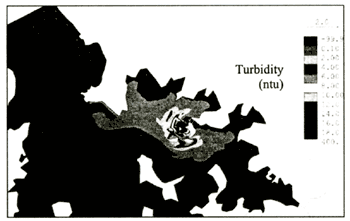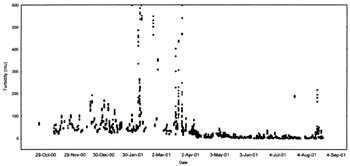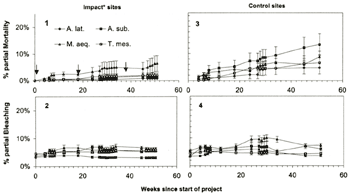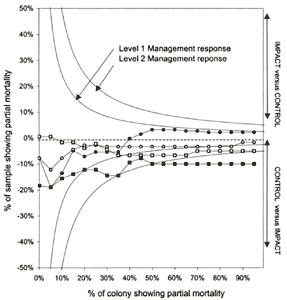|
Management responses: When the pre-discharge warning trigger values were exceeded, receiving waters were monitored. If the trigger values for receiving waters were exceeded, discharge was shutdown. In the instance that pre-discharge shutdown trigger values were exceeded discharge ceased immediately and receiving waters were monitored.
Dredge Plume Monitoring - East Arm Port
Dredging was conducted to remove 〜1.15M m3 of soft marine sediment as part of Stage 2 extensions for Port of Darwin (12°30'E, 130°50'S).
Key habitats: The development was undertaken adjacent to the Charles Darwin National Park, a coastal mangrove and estuarine habitat of regional importance. The mangrove communities were selected as the key habitat.
Pollutant-generating construction process: Dredging was undertaken via
cutter-suction dredge, a process known to create substantial sediment-laden surface and sub-surface plumes.
Therefore, dredging was regarded as the principal pollutant-generating process within the marine environment.
As excessive sediment deposition is recognized to substantially impact on mangrove condition ( eg
Ellison, 1998; Clarke and Myerscough, 1993; Fairweather, 1990), excessive sediment suspension was
identified as the key pollutant. For the purpose of this monitoring program, turbidity was used as a surrogate
measure of suspended sediment. As pre-discharge monitoring was not possible for dredging, predictive monitoring
of East Arm Port focused on a dredge plume-monitoring program.
Baseline monitoring: Background data on suspended sediment concentrations
and turbidity was available from previous projects undertaken for the Stage 1 development of East Arm
Port. These data were supplemented with a baseline-monitoring program for water quality at key habitat
and control monitoring stations. This series of data enabled determination of fluctuations in turbidity
of receiving waters associated with tidal phases (neap, spring). Baseline information was combined with
known physiological tolerances of mangrove habitats ( i.e., Frusher et al., 1994)
to derive key habitat tolerances for neap and spring tidal phases (Table 3).
Table 3. Key Habitat Trigger Values
| Tidal phase |
Trigger value |
| Spring |
27 ntu |
| Neap |
14 ntu |
|
Modelling and trigger values: To predict the turbidity concentration that could be generated by the construction process to meet key habitat tolerances, the results from the baseline study were incorporated within a far-field hydrodynamic model of dredge head sediment mobilisation (RMA-2; Fig.3). The outcome of this model was a set of warning and shutdown trigger values at the post-mixing boundary of the plume (40 m from the dredge head) for multiple dredge locations (Table 4).
| (Enlarge: 30KB) |
 |
Figure 3. RMA-2 model output used to determine warning and shutdown trigger
values at the post-mixing boundary of the dredge plume
Table 4. Dredge plume trigger values for the post-mixing boundary located 40 m from the dredge head
| Dredge location |
Trigger values |
| Shutdown |
Warning |
| Inside the port |
457 ntu |
190 ntu |
| At the tip of the port |
30 ntu |
16 ntu |
|
Validation studies: The efficacy of the dredge plume trigger values was validated by a 10-day pilot study undertaken at the commencement of works.
Compliance monitoring: The dredge plume and key habitat trigger values were applied in a compliance-monitoring program. Compliance was determined by comparing turbidity to the appropriate warning and critical trigger values. Raw turbidity data (n= 10 per station) were transformed and the 95% confidence interval of the mean was used to determine compliance with trigger values.
Routine biological monitoring - Mangrove Condition Monitoring Program: A Mangrove Condition Monitoring Program was implemented to validate the effectiveness of the PMP. A full description of this program and its findings will be published elsewhere by the authors. In brief, the program was conducted across a range of mangrove zones in two separate communities, these being Sonneratia alba and Rhizophora sp.. Condition indicators such as pneumatophore status, seedling recruitment, active crab burrow counts, active crab counts and mangrove snail counts were measured during each survey. Various stress indicators, including yellowing of leaves, aborting of fertile material, fragility and loss of turgidity in pneumatophores, excessive/unusual predation and disease were also recorded.
Management responses: When dredge plume warning trigger values were exceeded, receiving waters were monitored. If the trigger values for the receiving waters were exceeded, dredging was shutdown. In the instance that the dredge plume shutdown trigger values were exceeded, dredging operations ceased immediately and receiving waters were monitored.
RESULTS
De-watering - Nelly Bay Safe Harbour Development
Water Quality Compliance Monitoring
Turbidity of de-watering discharges varied markedly during construction (Fig.4) and water quality trigger values were exceeded on 113 occasions during pre-discharge compliance monitoring (Table 5). On each of these occasions, a variety of management responses were implemented, including shut down of discharge activities and implementation of receiving water monitoring. On two occasions only receiving waters were found to be non-compliant to key habitat trigger values during the de-watering process.
| (Enlarge: 16KB) |
 |
Figure 4. Turbidity (ntu) of the discharge waters as measured in the discharge
pipe from October 2000 to August 2001
Table 5. Discharge and receiving water compliance monitoring results
| Trigger values |
Number of exceedances |
| Discharge non-compliance |
| Warning |
77 |
| Shutdown |
36 |
|
Coral Condition Monitoring Program
During 11 months of de-watering, all coral colonies exhibited less than 15% partial bleaching or partial mortality (Fig.5). Coral condition surveys did not identify exceedance of warning (Level 1) or shutdown (Level 2) habitat trigger values for the percentage of partial bleaching or percentage of partial mortality (e.g., Fig.6; partial mortality). Thus no construction related impacts could be identified.
| (Enlarge: 26KB) |
 |
Figure 5. Mean percentage partial mortality and bleaching in Acropora latistella, A. subulata, Montipora aequituberculata and Turbinaria mesenterina. Data are expressed as mean ± SD (standard deviation)
| (Enlarge: 41KB) |
 |
Figure 6. Decision curve analysis for partial mortality as measured by the
Coral Condition Monitoring Program after 51 weeks ● = Montipora aequituberculata, ■ = Acropora subulata,
○= Acropora latistella, □= Turbinaria mesenterina
Dredge plume monitoring - East Arm Port
Water quality compliance monitoring
Water quality remained compliant to warning and shutdown trigger values for the duration of dredging. On one occasion however, a substantial turbidity increase was observed within the receiving environment. This was due to the release of turbid dredge decant waters following the failure of a bund wall. Non-compliance with key habitat trigger values was recorded on the day following the bund failure.
Mangrove Condition Monitoring Program
According to the physiological indicators of mangrove stress, including pneumatophore turgidity and leaf yellowing, no difference in mangrove condition was identified between impact and control stations. Also, indicators of habitat condition, including active crab burrow count (sesarmid crabs are known to leave areas which are smothered by deep sediments) did not indicate an impact associated with increased sedimentation (Fig.7).
Figure 7. Mean total number of crab burrow counts for the duration of the
project
|